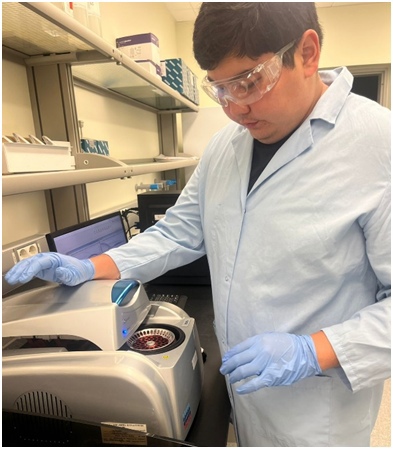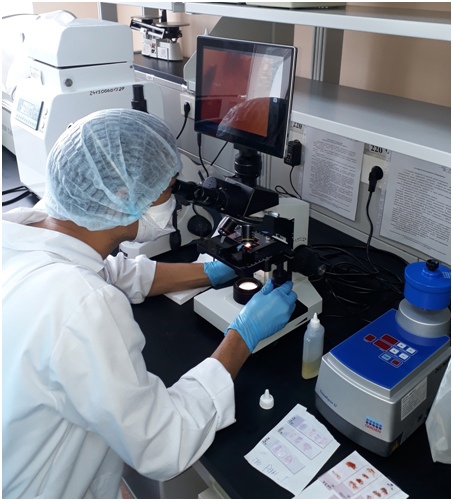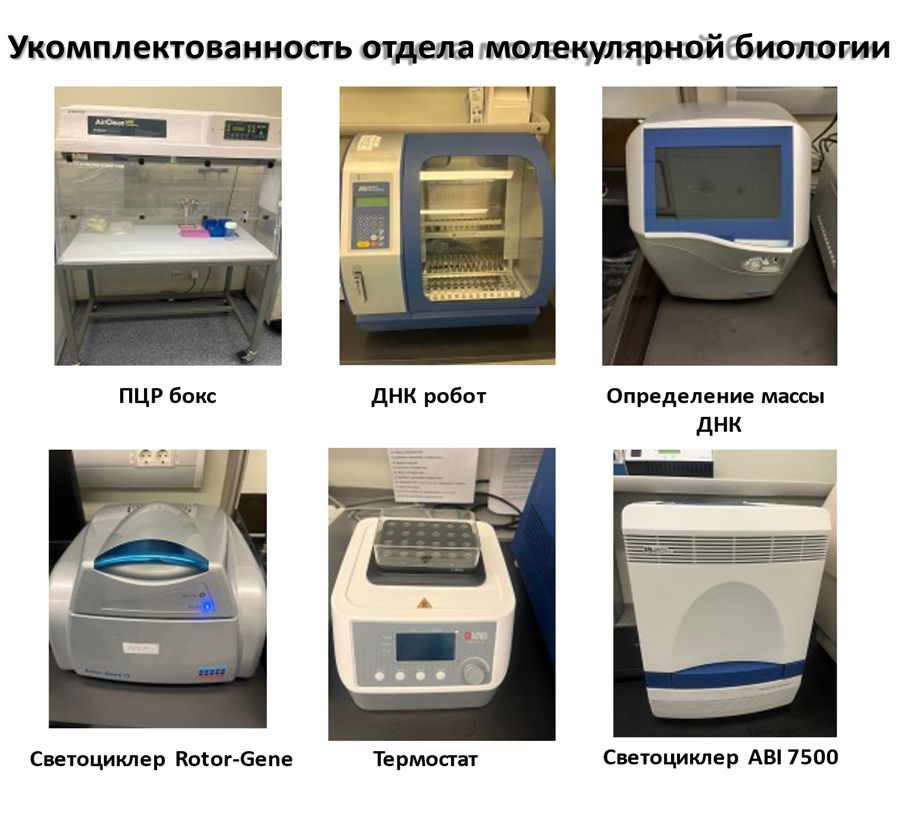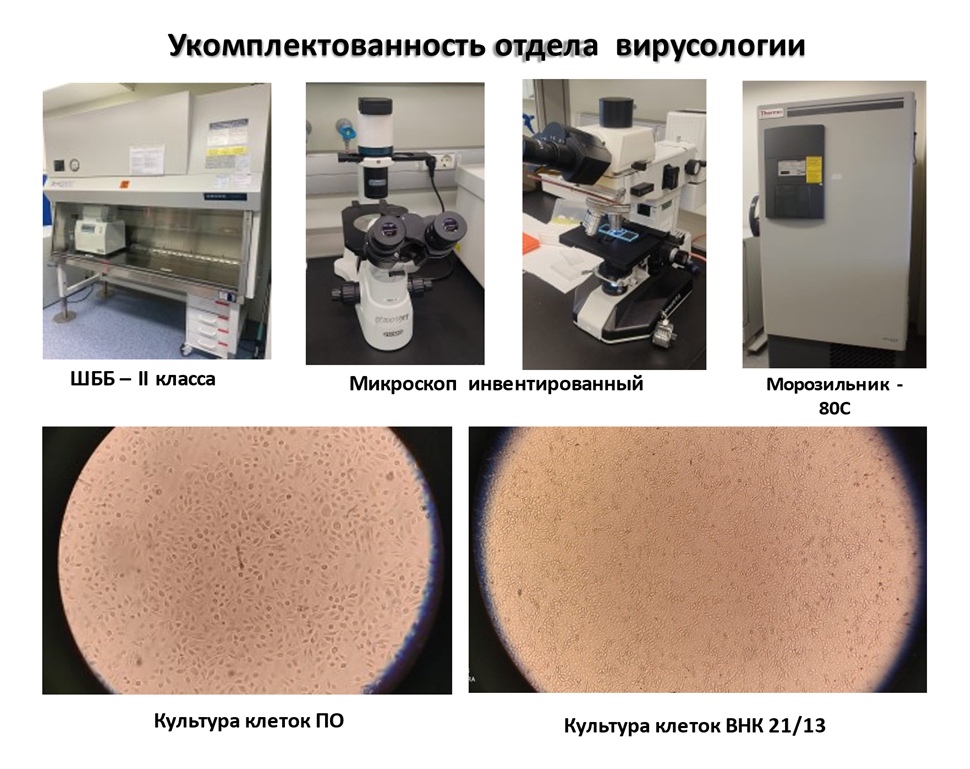Suleimenov Serik Tolepbergenuly
+7 (727) 251-05-29
afdiznrcv@mail.ru
Zhakhanger street 14
ACTIVITIES OF THE LABORATORY
The laboratory for diagnosing infectious diseases AF (hereinafter referred to as DIZ) is located in the building of the Central Reference Laboratory (hereinafter referred to as CRL) in Almaty, has laboratories of 2 and 3 levels of biological safety in accordance with international requirements (UBB-2 / BSL2, UBB-3 / BSL- 3).
UBB-2 and UBB-3 laboratories are equipped with modern laboratory equipment, including devices for biochemical and molecular biological procedures (high-speed ultra-centrifuges, real-time PCR apparatus), immunological procedures (luminescent microscope, ELISA device), pathogen cultivation and cells (microscopes, thermostats, anaerobic chambers) ensuring biological safety (biological safety cabinets), as well as standard laboratory equipment (water baths, nitrogen cryostats, freezers at -200C and -800C).
The activities of the DIZ AF laboratory include:
Conducting reference laboratory studies of biomaterial delivered from veterinary facilities in the South-Eastern regions of the Republic of Kazakhstan.
Carrying out monitoring laboratory studies of biomaterial from animals and birds of wild fauna.
Conducting an analysis of the epizootic situation for infectious diseases at veterinary agricultural facilities, as well as wild fauna.
Implementation of visits of specialists for the selection of biomaterial at the sites of veterinary facilities.
Implementation of advisory assistance to veterinary specialists at the regional and district levels.
DEPARTMENT OF BACTERIOLOGY
Bacteriological studies in the DIZ laboratory are used to isolate bacteria and study their properties to make a microbiological diagnosis.
General information about the department and staffing
Bacteriological studies are carried out in laboratories UBB-2 and UBB-3, rooms for bacteriological studies in DIZ laboratories are equipped with biosafety cabinets of the 2nd level and all the necessary equipment for bacteriological studies (homogenizer, thermostats, biological microscopes, water baths, anaerostats, etc. .).
The laboratory also uses laboratory animals as biological models for conducting biological samples with infection in certain diseases to identify pathogens and determine their virulent properties.
Bacteriological studies are carried out for diseases such as brucellosis, tuberculosis, paratuberculosis, anthrax, listeriosis, staphylococcus aureus, campylobacteriosis, pasteurellosis, anaerobic infections (emkar, bradzot, anaerobic enterotoxemia), enterobacterial infections (salmonellosis, colibacteriosis).
SEROLOGY DEPARTMENT
Serological reactions in the DIZ laboratory are used for diagnostic purposes, identifying the source of infection, serotype, immune background and determining the epizootic situation by conducting screening studies among animals and birds in agriculture, as well as wild fauna. The principle of serological reactions is based on the interaction of antibodies and antigens in the animal body.
General information about the department and staffing
Applied methods:
– Enzyme-linked immunosorbent assay (ELISA) to detect antibodies or antigen to such diseases as brucellosis, foot and mouth disease, Newcastle disease, leukemia, chlamydia, rhinopneumonia of horses, infectious rhinotracheitis, infectious anemia of horses, avian influenza, viral diarrhea, African and classical swine fever, bluetongue, paratuberculosis, Schmallenberg’s disease, etc.;
For brucellosis, in addition to ELISA, the complement fixation reaction (RCC), the rosbengal test (RBP) and the immune diffusion reaction with O-polysaccharide antigen (RID with OPS antigen) are used;
For leukemia, in addition to ELISA, an immune diffusion reaction (RID) is used, as well as a hematological analysis according to the leukocyte formula;
For rabies, the methods of immunochromatographic analysis (ICA) and the direct method of immunoluminescent microscopy (PMIM) using diagnostic anti-rabies fluorescent immunoglobulin (IDAF) are used;
DIZ laboratories are equipped with all the necessary equipment and instruments for serological testing, such as an ELISA analyzer in the kit, automatic and semi-automatic dispensers, water baths, etc.
DEPARTMENT OF MOLECULAR BIOLOGY
The DIZ laboratory uses the method of molecular genetic studies of biological material, such as polymerase chain reaction (PCR), taking into account the results both in real time (real-time PCR) and taking into account in electrophoresis, in order to identify nucleic acids (DNA/ RNA) of certain microorganisms, to diagnose infectious diseases and determine the epizootic situation among animals and birds in agriculture, as well as wild fauna.
PCR is used to repeatedly increase DNA fragments specific to certain microorganisms.
General information about the department and staffing
To conduct molecular biological research in DIZ laboratories, standard room separation zones are used:
1-DNA/RNA extraction room equipped with a level 2 biosafety cabinet and all necessary equipment for isolation (high-speed centrifuges for microtubes, thermostats for test tubes, thermal stirrers, etc.).
2-room for preparing master mixes equipped with a PCR box and all necessary equipment.
3rd room for PCR. Equipped with PCR machines for real-time PCR and classical PCR.
4th Room. room for electrophoresis.
The PCR method in the DIZ laboratory is used to isolate DNA / RNA of such pathogens as brucellosis, foot and mouth disease, b. Newcastle, leukemia, chlamydia, RTI, HPAI, bovine viral diarrhea, ASF, CSF, bluetongue, tuberculosis. paratuberculosis b. Schmallenberg, listeriosis, leptospirosis, etc.
DEPARTMENT OF VIROLOGY
Virological studies in the DIZ laboratory are carried out to isolate the virus, determine the type of virus strain, and determine the intensity of immunity.
In the virological department, studies are carried out by various methods: virological (studies on chicken embryos, cell cultures), serological (hemagglutination inhibition test – RTHA, hemagglutination reaction – RHA, neutralization reaction – RN), microscopic (light and luminescent microscopy) and others.


General information about the department and staffing
Applied methods:
– The neutralization test (RN) is a universal test that serves as a reference for assessing other serological tests. Its principle is that when an antigen (virus) interacts with homologous antibodies, an antigen + antibody complex is formed, as a result, the infectivity of the virus is neutralized. Immune serum antibodies are able to neutralize the damaging effect of microbes or their toxins on sensitive cells and tissues, which is associated with the blockade of microbial antigens by antibodies, i.e. their neutralization.
– The hemagglutination inhibition test (HITA) is a method for identifying a virus or detecting antiviral antibodies in the patient’s blood serum, based on the phenomenon of the absence of agglutination of erythrocytes by a drug containing a virus in the presence of blood serum immune to it. RTGA is based on the blockade, suppression of antigens of viruses by antibodies of the immune serum, as a result of which the viruses lose their ability to agglutinate red blood cells.
DEPARTMENT OF EPIZOOTOLOGICAL MONITORING
Ensuring monitoring of pathogens of especially dangerous infections of farm animals and birds is one of the main ways in creating the foundations of a biological safety system in the Republic of Kazakhstan.
At present, the study of the epizootic situation of especially dangerous human and animal infections has become an urgent problem for many countries of the world, including our state.
The main activities of the epizootic monitoring department are:
– formation of reports for epizootological analysis based on the results of the study and forecasting of expected diseases for subsequent years;
– use of a geographic information system based on the ArcGis Desktop platform to create geographic maps with an epizootic situation;
– carrying out visits to veterinary facilities for sampling from agricultural animals;
– organization of events for the implementation of expeditions for sampling among wild fauna;
– monitoring of information sources of foreign countries on outbreaks of animal diseases;
– taking into account information on animal diseases in the world received from official sources such as the International Epizootic Bureau (OIE), the Food and Agriculture Organization of the United Nations (FAO), Rosselkhoznadzor, PubMed CDC, etc.
The most dangerous diseases periodically manifest themselves in certain countries, the pathogens of which are capable of being transmitted from a sick animal to a healthy one, and often to humans – such as foot-and-mouth disease, anthrax, brucellosis, rabies, etc. This determines the possibility of continuous transmission of pathogens of an infectious disease, the mass nature of the defeat animals and a tendency to a wide territorial distribution.











